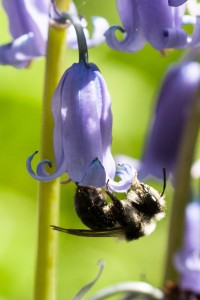There has been a lot of debate about green belt land and building on brown field sites, but the importance of urban spaces is often overlooked. A recently published paper by M.H. Surohi e al looked at the populations of bees (solitary and eusocial, the latter being where a non-reproductive individuals care for the young of a single female as is the case with bumblebees) in an urban centre – in this case Northampton, the town where I work.
They surveyed several sites over the flight periods of the bees (March to October) within 500 metres of the geographical centre of the town (aka All Saints Church) and also some sites slightly further out that were local nature reserves or orchards. Their results were somewhat surprising (especially if you know how built up the middle of Northampton is) and found 48 species of bees within the town, representing 22% of the known species of bee (there are just over 250 in the UK) including one that is nationally rare. They also found that the urban sites were more diverse and abundant in bees than the meadows and nature reserves on the edge of town. The areas surveyed in the town consisted of roadside verges and roundabouts, gardens and churchyards.
Most of the bees were seen in the period from March to June, and the most dominant genus was that of the mining bees, Andrena which shows the importance of having non-tarmaced areas! Less surprising was the fact that hte most abundant species was Osmia Bicornis, the mason bee which nests in walls – it would find plenty of those in the middle of Northampton.
All this makes me even more determined to try and determine the insects sharing the hospital site in Northampton – I have already seen the ashy mining bee there along with its nomada parasite. Time to get my camera out…
Ashy mining bee, Andrena cineraria, not at the hospital
